
|
A boomerang is a fake if it is not made in Australia (but is labelled as if it was)
Boomerangs are traditional Australian Aboriginal Cultural objects which are sold as souvenirs to tourists. So too are bullroarers and didgeridoos. According to Justice Perry, consumers are entitled to assume they are made in Australia because they are Australian Cultural Objects. If they are made elsewhere, the place they are made must be clearly labelled, otherwise, the souvenir seller may face prosecution for selling a fake. And if the label says ‘hand painted’, then an Aboriginal person must have done or supervised the painting. The decision is Australian Competition and Consumer Commission v Birubi Art Pty Ltd [2018] FCA 1595 (23 October 2018), Federal Court of Australia.
The Facts Over the period 1 July 2015 and 14 November 2017, Birubi Art sold 18,000 objects (boomerangs, bullroarers, didgeridoos and message stones) which contained visual images, symbols and styles of Australian Aboriginal art to approximately 152 retail outlets across Australia. The Court found that these objects and their labels conveyed the overwhelming impression to the buying public that the objects were made in Australia and were hand painted by an Australian Aboriginal. In fact, the objects were made in Indonesia, and no Australian Aboriginal person was involved in their manufacture. The objects had no country of origin label. Even if they had, it is unlikely to have altered the impression.
What impression did the boomerangs and other objects convey to the public? The loose boomerangs The boomerang and its labelling conveyed the impression of a connection with Aboriginal Australian culture and of authenticity and provenance of having been made in Australia:
The boxed boomerangs The boomerang, plaque on the stand, labelling and packaging conveyed the same impression as the loose boomerangs. In addition:
The Bullroarers (in a box)
The Didgeridoos The bamboo didgeridoo souvenir and its labelling conveyed the same impression as the loose boomerangs. In addition:
The Message Stones The message stones are not as recognisable Australian Aboriginal Cultural objects, did not convey the same impression, and the label simply states: “ABORIGINAL ART” and “HAND PAINTED”.
The breaches of the Australian Consumer Law The Court found these representations were conveyed: made in Australia and hand painted by an Australian Aboriginal. They were not expressly stated, they were implied by impression from images and words on the objects, the labelling and packaging. The Court found that the overwhelming impression given to the reasonable purchaser at a souvenir outlet by the objects was:
The Court found it reasonable that a purchaser would rely on the impression, and not closely examine what was stated on the label and make further enquiries:
For these reasons, purchasers would be ‘likely’ and indeed ‘liable’ to being misled that:
In reaching its decision, the Court dismissed these arguments by Birubi Art:
Conclusions Commercially, most souvenirs sold in Australia are sourced from overseas (primarily Asia) because they are cheaper to make than in Australia. The Federal Court has now drawn a line - traditional Australian Aboriginal Cultural objects (boomerangs, bullroarers and didgeridoos) must be sourced within Australia because consumers make that assumption, unless they are clearly labelled as sourced elsewhere (usually Indonesia or Vietnam). And if described as ‘hand painted’, they must be hand painted by an Australian Aboriginal person. If not made in Australia, they are fake Aboriginal artefacts, and suppliers and sellers may be liable to prosecution for false and misleading representations under the Australian Consumer Law unless their country of origin is clearly marked The proceedings will now return to Court for orders to be made. These orders normally include an injunction, civil penalties, a disclosure order, a compliance program and a legal costs order. However, the further orders may be academic because a few days after the decision was handed down, a liquidator was appointed to Birubi Art Pty Ltd (In Liquidation) by its shareholders. This means that it will cease to carry on business. Whether the ACCC seeks orders against Mr Wooster, the sole director, remains to be seen. Marketing Commentary by Michael Field, EvettField Partners - Tourism represented 3.2% of Australia's GDP in the financial year 2016/17, contributing A$47.5 billion to the national economy. There were 8.8 million tourist arrivals in 2017. Previous research suggests that expenditure on shopping comprises almost a third of the total travel spend. Purchasing souvenirs is an essential part of the travel and shopping experience for international visitors and tourists. Souvenir purchases allow the visitor to ‘capture the travel experience’ and take it home with them to make the experience tangible; share the experience with others; and remind themselves of the experience long after they have returned home. Unlike stuffed koalas and kangaroos, or fridge magnets depicting the opera house, it is entirely reasonable for a visiting tourist to expect that cultural artefacts displayed for sale as ‘hand painted by Australian Aboriginal persons’, to be genuine. It would mislead the tourist and devalue their experience if the boomerang, bullroarer or didgeridoo was made in Indonesia, but sold as Australian made. The ACCC is right to pursue this. Given the enormous financial contribution that tourism makes to the Australian economy, and the emotional investment and connection that visiting tourists are likely to make when purchasing a souvenir that is presented as ‘authentic’, it is essential that vendors make honest representations about the products they are selling, and in this case, source Aboriginal cultural artefacts from Aboriginal persons |
|||||||||||||||||||||||||||||||||||
|
© Copyright 2022 Cordato Partners |
||||||||||||||||||||||||||||||||||||
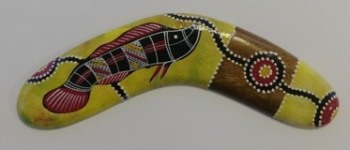 A
boomerang is readily
recognisable as a
traditional Australian
Aboriginal Cultural object,
in this case featuring
visual images characteristic
of Australian Aboriginal art
as painted by Australian
Aboriginal artists.
A
boomerang is readily
recognisable as a
traditional Australian
Aboriginal Cultural object,
in this case featuring
visual images characteristic
of Australian Aboriginal art
as painted by Australian
Aboriginal artists.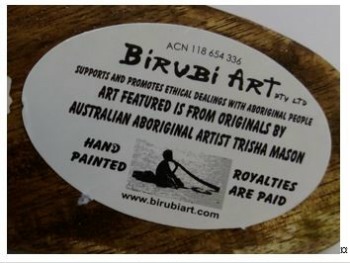 The
label at the back states:
The
label at the back states:
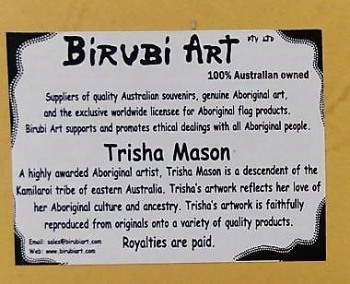 The
stand has a plaque which
states: “handcrafted
Australian boomerang”
The
stand has a plaque which
states: “handcrafted
Australian boomerang”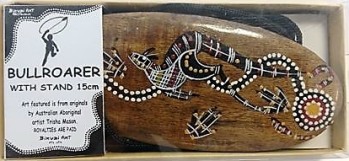 The
bullroarer, labelling and
packaging conveyed the same
impression as the boxed
boomerangs. In addition, the
Australian Aboriginal artist
Trisha Mason is identified as
the artist whose designs are
used for the bullroarer, and to
whom royalties are paid.
The
bullroarer, labelling and
packaging conveyed the same
impression as the boxed
boomerangs. In addition, the
Australian Aboriginal artist
Trisha Mason is identified as
the artist whose designs are
used for the bullroarer, and to
whom royalties are paid. 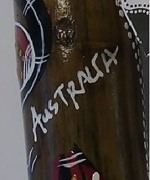
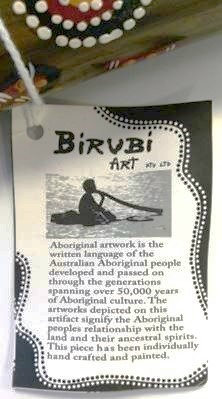 On
the label is “individually
hand crafted and painted”.
On
the label is “individually
hand crafted and painted”.